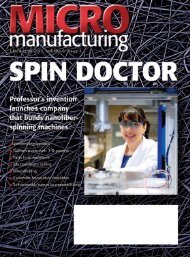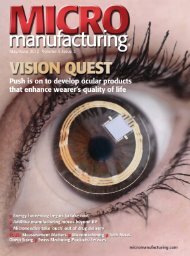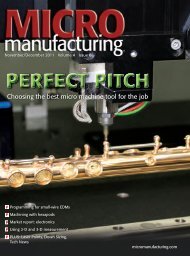Click here to view as PDF - MICROmanufacturing
Click here to view as PDF - MICROmanufacturing
Click here to view as PDF - MICROmanufacturing
You also want an ePaper? Increase the reach of your titles
YUMPU automatically turns print PDFs into web optimized ePapers that Google loves.
process. “For an SEM <strong>to</strong> work it h<strong>as</strong> <strong>to</strong><br />
be in a vacuum,” said Phenom-World’s<br />
Schipperen. “Every time you load and<br />
unload samples, you have <strong>to</strong> evacuate, or<br />
pump-down, the vacuum chamber, which<br />
can take 5 or 6 minutes.”<br />
A table<strong>to</strong>p SEM vacuum system typically<br />
provides rapid pump-down, from 20<br />
seconds <strong>to</strong> 1 minute, allowing analysis <strong>to</strong><br />
begin sooner. “Some of this is predicated<br />
on table<strong>to</strong>p units having smaller chambers,”<br />
said Greg Ott, president of ASPEX<br />
Corp., Delmont, Pa., manufacturer of the<br />
PSEM eXpress table<strong>to</strong>p unit.<br />
Phenom’s unit incorporates a sample<br />
cup that attaches <strong>to</strong> the machine instead<br />
of using a stage in the vacuum chamber.<br />
Only the cup h<strong>as</strong> <strong>to</strong> be evacuated—not<br />
the entire chamber. Pump-down time is<br />
less than 30 seconds.<br />
However, using the sample cup instead<br />
of a stage limits the sample size.<br />
“That is the tradeoff with the Phenom,”<br />
said Schipperen. “The maximum sample<br />
size is 1" in diameter. That is still pretty<br />
big for a sample size, though. If you are<br />
going <strong>to</strong> enlarge something up 10,000×,<br />
you don’t need a lot of it.” The manufacturer<br />
does offer larger, cus<strong>to</strong>mized sample<br />
containers.<br />
The maximum sample size for most<br />
table<strong>to</strong>p units is around 70mm in diameter<br />
× 50mm high.<br />
Also making things f<strong>as</strong>ter and e<strong>as</strong>ier,<br />
table<strong>to</strong>p SEMs eliminate the range of accelerating<br />
voltages from which the user<br />
must choose. Conventional SEMs feature<br />
accelerating voltages ranging from<br />
approximately 0.1kV <strong>to</strong> 30kV. The higher<br />
the voltage, the deeper the penetration of<br />
the beam in<strong>to</strong> the sample. However, the<br />
higher voltage can damage some beamsensitive<br />
samples and decre<strong>as</strong>e the image<br />
surface detail. Higher accelerating voltages<br />
are also required for energy-dispersive<br />
X-ray analysis systems, used for<br />
elemental identification.<br />
Most table<strong>to</strong>p models offer users just<br />
a few accelerating voltages, such <strong>as</strong> 5kV,<br />
10kV, 15kV and 20 kV. “The lower voltages<br />
give you better surface imaging,”<br />
said Robert J. Gordon, vice president of<br />
the Nanotechnology and Life Science<br />
Division of Hitachi High Technologies<br />
The table<strong>to</strong>p SEM bridges the gap between optical<br />
microscopy and full-blown electron microscopy.<br />
America Inc., the Ple<strong>as</strong>an<strong>to</strong>n, Calif., manufacturer<br />
of the TM-1000 and TM-3000<br />
table<strong>to</strong>p SEMs. “At lower voltages, the<br />
beam is not <strong>as</strong> energetic and you can use<br />
beam-sensitive materials.”<br />
Another feature that makes table<strong>to</strong>p<br />
SEMs e<strong>as</strong>y <strong>to</strong> use is they are not<br />
<strong>as</strong> affected by noise and vibration <strong>as</strong><br />
traditional SEMs. Imaging at high magnification<br />
in a conventional SEM requires<br />
an environment free from vibration, ambient<br />
noise and electromagnetic interference.<br />
“Because table<strong>to</strong>p SEMs have lower<br />
magnifications, vibration is not always a<br />
major fac<strong>to</strong>r,” said Wolfe. Most of the table<strong>to</strong>p<br />
units feature vibration-dampening<br />
systems <strong>as</strong> well.<br />
One dramatic difference between conventional<br />
and table<strong>to</strong>p SEMs is cost. Traditional<br />
SEMs start around $120,000 and<br />
go up <strong>to</strong> $700,000. Table<strong>to</strong>p models start<br />
Nikon Instruments<br />
Nikon’s NeoScope<br />
JCM-5000 can<br />
inspect electronic<br />
components, such <strong>as</strong><br />
these printed circuit<br />
board connections.<br />
around $65,000. Le<strong>as</strong>ing is an option, but<br />
most cus<strong>to</strong>mers purch<strong>as</strong>e them outright.<br />
Another difference is maintenance. “I<br />
used <strong>to</strong> shudder when I heard t<strong>here</strong> w<strong>as</strong><br />
a problem with our [conventional] SEM,”<br />
said Courtney Martin, manufacturing<br />
engineer at Adaptive Materials Inc., an<br />
Ann Arbor, Mich.-b<strong>as</strong>ed fuel cell manufacturer<br />
that uses the Hitachi TM-1000.<br />
“Conventional SEMs require constant<br />
care and preventative maintenance for<br />
their multiple parts, and ample training<br />
<strong>to</strong> get great images.”<br />
Maintenance issues are typically minimal<br />
with table<strong>to</strong>p SEMs. One consumable<br />
is the filament, the source for<br />
electron generation. Most table<strong>to</strong>p SEMs<br />
feature a tungsten filament, which is simple<br />
for the user <strong>to</strong> replace. However, they<br />
typically have just a 200-hour life.<br />
The Phenom unit’s lanthanum-hexaboride<br />
source provides 1,500 hours of operation.<br />
“It l<strong>as</strong>ts longer and gives a brighter<br />
image than the tungsten, but is quite a<br />
bit more expensive,” said Schipperen. The<br />
micromanufacturing.com | 41















